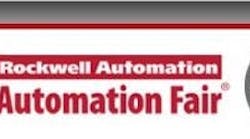Over the next decade, U.S. manufacturing will need to fill 3.5 million jobs. “We already have jobs unfilled,” said Patrick Murray, director, market development, Services and Solutions, Rockwell Automation. “Industry gets a lot of resumes, but not the right skill sets, or even the right background to train them in the needed skills in maintenance, operations, networking—the technical knowledge required for today’s manufacturing.”
That’s mainly due to the wave of retiring older workers, but also because workers lose time to injuries, and manufacturing struggles to attract talent when it has a reputation as a place where people get hurt.
We’ve all heard about the skills shortage, but what can we do about it? Murray offered a selection of answers in a tour of the Services and Solutions booth at Automation Fair this week in Atlanta. But first, he described the dimension of the problem.
“By our calculations, if we don’t improve productivity and two million of those jobs are unfilled in 2020, it will reduce economic growth by 40%,” Murray said. “Workforce challenges resulting from aging workers leaving the workforce and being replaced by less experienced, early career workers – if they can be replaced at all – are being felt around the world, in Europe and Latin America.”
China is seeing similar shortage as its middle class grows and buys TVs, washing machines and microwave ovens—McKinsey & Company estimates the country’s demand for highly skilled workers will exceed the number of available workers by 24 million in 2020. “And if we don’t manage safety, we’ll exacerbate it, by having people off the job, and having people not want to work in industry,” he said.
According to PwC, more than half of industrial manufacturing CEOs (53%) intend to hire more people, but 74% are worried about the shortage of key skills. “Boomers are leaving fast, leaving a hole, and not there to train young people,” Murray said. “Intellectual property is leaving that we need to capture.”
Changing technology landscape
The missing skills are primarily technical, so the skills gap also must be considered in the context of the changing technology landscape. Manufacturing and industrial operations have evolved far beyond the days of the assembly line when factory workers labored side by side, completing dedicated repetitive jobs.
“In fact, industrial operations will more radically change in the next five years than they have in the last 20, and the Internet of Things (IoT) is a catalyst in this shift,” Murray explained. As global pressures continue to grow, companies need to find innovative ways to use advancing Internet-ready technologies to meet demand. “As you’ve heard, we call this The Connected Enterprise.”
[sidebar id =1]The Connected Enterprise is creating new opportunities for manufacturers and industrial operators to increase productivity and reduce safety risks, and can even help address the challenges of today’s evolving workforce. But the convergence of existing systems and the adoption of new technologies that enable this transformation are also placing new burdens on the workforce. “We’ll be collecting 15 trillion gigabytes of data by 2020,” Murray said. “We have to manage it, or it’s just worthless.”
“Only 39% of companies have introduced training in digital skills. One-third have a formal IIoT initiative, and one-third expect to have one in the next three years. That means one-third are not even thinking about it.”
Safety takes its toll
Meanwhile, older workers are at higher risk for certain injuries. For example, they may be slower to recognize and react to hazards, and their ability to lift or carry heavy objects diminish, making them more prone to injuries.
Younger and less experienced workers are more frequently injured and tend to have more serious injuries. Organizations should consider restructuring roles and responsibilities as part of the digital transformation, Murray said.
“Workforce availability and the skills gap challenge are long-term, multifaceted challenges,” Murray said. “There is no single or short-term fix, but there are key steps you can take to better prepare your operations and empower your workers to cope with the challenges ahead.”
These include:
- Build a Connected Enterprise to improve productivity and efficiency
- Train workers to manage knowledge transfer and develop new skills to enable IT/OT convergence, and take advantage of new technology
- Where training doesn’t make sense, leverage vendors and suppliers to augment core competencies with domain expertise
- Tap new and expanding network and security services to better define, design, deploy, manage and monitor the right network infrastructure for your plant
- Prepare for people and asset safety with assessments, engineered offerings, pre-engineered solutions and a remote audit-and-tracking service to help ensure people follow proper procedures
- Go beyond a keep-it-running mindset and make the most of your production infrastructure with asset and plant optimization services
- Find the solutions tailored to your industry or application
“Oil and gas is different from food and beverage,” Murray said. “There is no silver bullet, no one-size-fits-all solution.”
Connect that enterprise
Along with being smart and secure, The Connected Enterprise converges IT and OT systems, and enables Internet of Things (IoT) devices, wireless, mobility and data analytics. “This is creating unprecedented opportunities to access and act on information to address skills-gap challenges,” Murray said.
Real-time production data can be collected and delivered in a context relevant to each employee to reduce complexity for younger, less experienced workers. And because young people are more frequently injured, safety data also can be collected to identify risks and gain visibility into where safety-related incidents are occurring.
Remote-monitoring technologies can keep an eye on equipment, collect performance analytics and identify issues in dispersed or remote operations. This can reduce travel demands and improve work-life balance for older workers who may otherwise be considering retirement. If local talent isn’t available, third-party services can remotely monitor equipment to augment the on-site team.
Mobile devices can improve collaboration among workers. For example, real-time video communications can connect a less-experienced worker with a remote expert to troubleshoot a machine failure right on the plant floor. Mobile devices also provide information to younger workers in a format with which they are familiar.
Train, train, train
Training will be vital for the new generation of workers taking the place of more experienced workers. “That’s why it’s important that your training be strategic,” Murray said.” It should be tailored based on data and on defined needs, not historical preference or opinion.” Creating a highly skilled workforce through effective training is not a one-time event but an ongoing process. And that process should be built around four key steps:
- Assess: Conduct an assessment to evaluate where your skills or knowledge gaps are, and then develop a plan to fill them
- Train: Employ a tailored, training approach that matches employee needs and aligns with business goals
- Hone: Use job aids and refresher tools to help employees continuously practice and improve their skills
- Optimize: Capture pre- and post-training data to measure training effectiveness, and refine where needed
“That’s a tall order, and few companies can fill it on their own,” Murray said. Immersive training services, such as the Rockwell Automation Accelerated Skills Academy, can provide a rapid approach to employee development to specifically address workforce skills gaps.
Connecting operations does more than bring together enterprise-level information technology (IT) systems and plant-level operations technology (OT). It also brings together IT and OT roles that previously operated separate from each other.
IT and OT workers now require a blended mix of skills and knowledge encompassing both disciplines. To help fill the gap, Rockwell Automation and Cisco have developed an Industrial Networking Certification program, designed for both IT and OT professionals. The Industrial IP Advantage, an educational community supported by an industry coalition, offers e-learning courses in areas such as logical topologies, protocols, switching and routing infrastructure, physical cabling and wireless.
Get served
“But training the workforce you have and will have in the future will not be enough,” Murray said. “Service providers can support core competencies and fill skills or knowledge gaps.”
- Consulting services can provide a workforce gap analysis and remediation plan. They also can conduct network, safety and security assessments
- Remote support and monitoring services can complement on-site maintenance teams, providing continuous machine monitoring, 24/7 live support and software/firmware updates.
- Resident engineers can help keep operations running when qualified talent isn’t available, such as for facility upgrades or operation start-ups.
- Data integration and contextualization services can help you capture data and convert it into actionable information, providing new opportunities to increase productivity.
- Electrical safety services help manufacturers comply and perform routine maintenance without risking productivity.
Comprehensive lockout-tagout solutions help proactively manage employee safety while optimizing production efficiency. Arc Flash Analysis helps identify issues that could lead to an arc flash or blast. “We use a clearly-defined process to help improve safety, by identifying the steps that are required to assess and mitigate machinery risks,” Murray said. “With an assessment, we help to evaluate plant risk and support well-informed decisions that improve employee and machine safety.”
Asset management programs manage storerooms and rationalize inventory of parts around automation assets to ensure the right inventory for replacing failed parts, as well as make repairs.
“An aging and evolving workforce, combined with the new skills needed to capitalize on connected technologies, are driving an ever-widening skills gap. But you don’t need to face these challenges alone,” Murray said. “Our evolving and growing services and solutions help customers bridge these gaps to help them accelerate own their IoT journey, no matter where they are in the process.”
[sidebar id =2]

Leaders relevant to this article:




